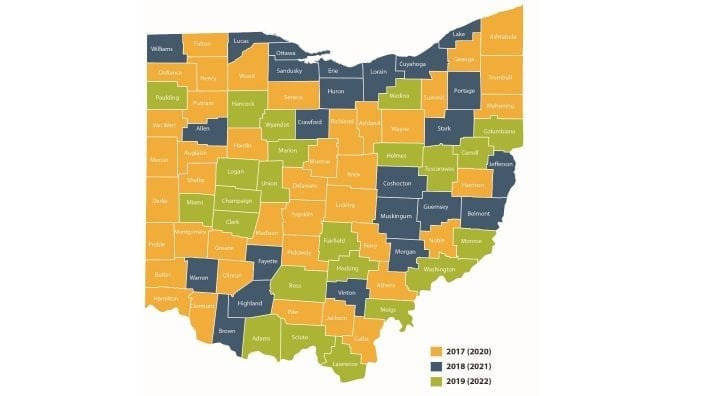Applications for Ohio Farm Bureau Health Plans now available
Members have three ways to apply: contacting a certified agent, calling 833-468-4280 or visiting ohiofarmbureauhealthplans.org.
Read MoreOhio farmland tax valuations continue to decline across the state according to a new study from Ohio State University. The study shows tax valuations have dropped by one third since the Current Agricultural Use Value formula was changed by the state legislature in 2017. Ohio Farm Bureau led the effort to make valuations more reflective of current farm economic factors.
Before the formula change, the average tax valuation of land in Ohio was $1,310 per acre. After the change, the average valuation was $875 per acre, according to the study done by agricultural economists Robert Dinterman and Ani Katchova with OSU’s College of Food, Agricultural, and Environmental Sciences.
Agricultural land values and the corresponding taxes paid on that land will continue to decline at an even faster rate, Dinterman said. Steeper decreases in taxes will be seen, on average, because the changes to the way the farmland is assessed have been phased in between 2017 and 2019. Small changes were made each year to avoid a sudden and dramatic drop in tax revenue, Dinterman said.
But in 2020, the phase-in will end, so Ohio farmland owners should see another one-third drop in the assessed value of their land, compared to the previous year, and similar declines in their taxes, Dinterman said.
The average tax paid across the state was about $36 per acre of farmland in 2016. That dropped to around $31 in 2017, Dinterman said. By 2020, the average likely will be around $25 per acre, which would match the rate paid in 2011, he said.
The legislative adjustment to the CAUV formula followed three years of grassroots efforts by Farm Bureau members who asked lawmakers to respond to dramatically higher farmland taxes at a time when the farm economy was slumping.
“Ensuring that farmers have accurate property tax values is integral to preserving farmland in our state,” said Ohio Farm Bureau Policy Counsel Leah Curtis.
Another Farm Bureau promoted change is also paying off, she said.
“The penalty on farmers who place land in conservation practices has been eliminated,” Curtis said. “Conservation lands are now being taxed at a lower rate, which helps farmers continue their efforts to protect water quality.”


Members have three ways to apply: contacting a certified agent, calling 833-468-4280 or visiting ohiofarmbureauhealthplans.org.
Read More

One of the best decisions Shannon and Heather Utter made a few years ago was looking into a Farm Bureau member benefit that has ended up saving them thousands of dollars on their energy bills.
Read More

Ryan Hiser has experienced first-hand the importance of having the opportunity to vote on issues that will affect his family operation and other farmers.
Read More

Bill Patterson, Cy Prettyman and Adele Flynn will continue to serve as officers for Ohio Farm Bureau Federation.
Read More

Delegates discussed many topics impacting agriculture including farmland preservation, local foods, and succession planning.
Read More

Twenty-six farmers govern the state’s largest farm and food organization.
Read More

The 2025 recipients are Fred Cooke (posthumous) of Richland County, Marvin Dietsch of Williams County, Steven Knollman of Hamilton County and Michele Miller (posthumous) of Ottawa County.
Read More

Nathan and Jill Parriman grow seasonal crops, including Christmas trees, pumpkins and cut flowers, providing U-cut experiences that invite customers to engage directly with agriculture.
Read More

The 2025 Distinguished Service Award recipients are Craig Adams, Mike Townsley, and Kellogg Farms, Kurt Farms and Stateler Family Farms.
Read More

Ohio Farm Bureau Treasurer Adele Flynn participated in the meeting, representing Ohio farmers.
Read More